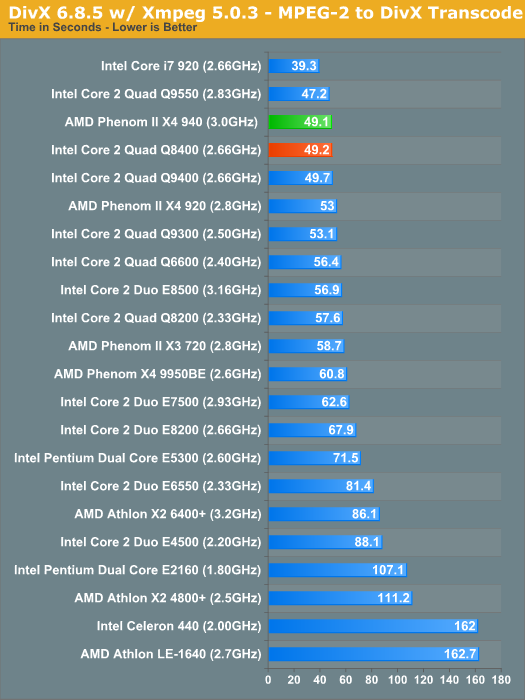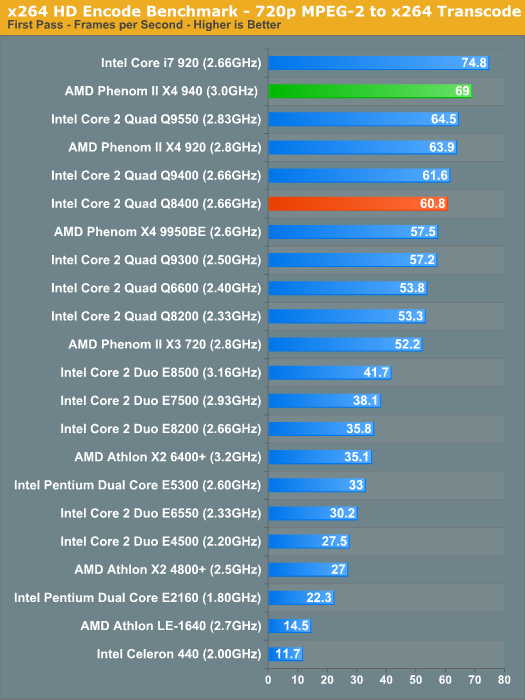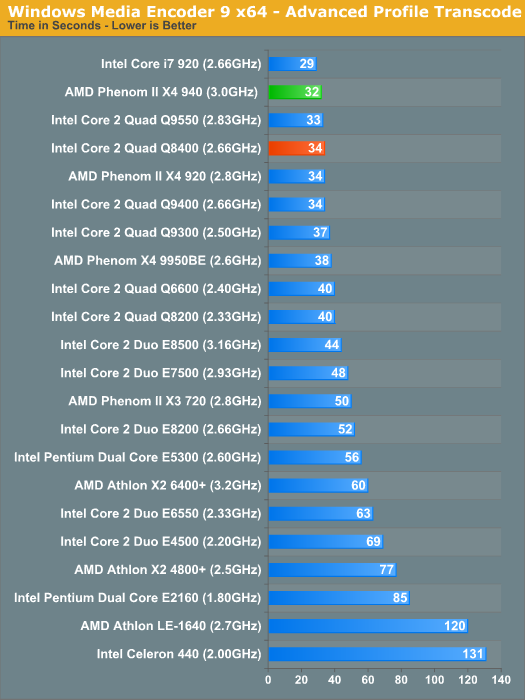The Core 2 Quad Q8400: Intel's $183 Phenom II 940 Competitor
by Anand Lal Shimpi on May 7, 2009 12:00 AM EST- Posted in
- CPUs
DivX 8.5.3 with Xmpeg 5.0.3
Our DivX test is the same DivX / XMpeg 5.03 test we've run for the past few years now, the 1080p source file is encoded using the unconstrained DivX profile, quality/performance is set balanced at 5 and enhanced multithreading is enabled:

Video encoding performance is a tie between our two competitors. Both perform among the fastest quad-core CPUs on the market today, but clearly under the devine i7. Looking at the Pentium E5300 performance we see that even early Core 2 Duo systems stand to see a 30% boost in performance by moving to one of these affordable quad-core alternatives.
If you want to extrapolate however, here's a fun game. It took Intel roughly three years to offer the performance of a $500 CPU in something that costs less than $80. By 2011 you'll be able to get this sort of performance at under $80 as well. Mmm, ubiquitous multi-core.
x264 HD Video Encoding Performance
Graysky's x264 HD test uses the publicly available x264 codec (open source alternative to H.264) to encode a 4Mbps 720p MPEG-2 source. The focus here is on quality rather than speed, thus the benchmark uses a 2-pass encode and reports the average frame rate in each pass.

AMD continues to have a large advantage in two pass x264 encoding thanks to a lot of unaligned loads that penalize Intel's pre-Nehalem architectures. The second, more strenuous pass shows the two contenders in a tie just as we saw in our DivX results:

Windows Media Encoder 9 x64 Advanced Profile
In order to be codec agnostic we've got a Windows Media Encoder benchmark looking at the same sort of thing we've been doing in the DivX and x264 tests, but using WME instead.

While DivX and x264 both showed our contenders as equals, our WME test has the Phenom II 940 in the lead by nearly 6%.










60 Comments
View All Comments
TA152H - Friday, May 8, 2009 - link
Because of Windows XP virtualization? Are you crazy?OK, here's a reality check for those who think Windows XP virtualization is the greatest thing since the Atom Bomb.
It's not, it's a kludge, and if you want Windows XP, get Windows XP. It's going to be slower, because virtualization does have overhead, and running it in some virtual mode isn't the same as running something in XP.
How many applications really only run in XP anyway???? Show me a software vendor in this day that only supports apps in XP, and I'll show you one that's going out of business, really soon. They're incompetent.
If you're a software vendor, whether you like it or not, Vista is taking over, simply because Microsoft has it pre-installed on the vast majority of machines.
Backwards compatibility of this type can be helpful in some situations, but the importance is getting way overblown. It's not a show-stopper for the vast majority of people buying a PC, price is, and the Pentium branded CPUs offered a lot of value for the performance they give, and are excellent products.
Judging them from something of limited use, on an operating system that has not even been released, about a feature Microsoft announced a few weeks ago, is completely unfair to Intel. Going back before the Microsoft announcement, did anyone think people would be using that feature much on a budget processor? It was a good way for Intel to avoid Pentiums being used in an unintended market. Now, they might change it, since the use is more universal, but it is hardly damning for them to not have included it.
I do not know when Microsoft decided to tell Intel about this, but, it could very well have been after Intel finalized their specifications on the chips. If Intel's next Pentiums do not have this feature, I might be a little less understanding of it, but really, it is does not remove them as a choice, because it is really not as useful as people are saying. I would probably never use the feature, virtually (no pun intended) all apps run on Vista now, or have a version that runs on it, and Windows XP apps running on Windows 7 will not be as fast as those running on Windows XP. I don't think I'll have too much need for this type of kludge. But if you do, get a processor that does support it.
GeorgeH - Friday, May 8, 2009 - link
Crazy? One can never be sure, but the voices say no.XP Mode is something most people will never need, use, or be aware of and is most definitely not the best thing since the "Atom Bomb." (Aside: If the "Atom Bomb" is your go-to comparison for all things great, you might want to do some crazy checks of your own.)
Both AMD and Intel offer about the same performance at the same price points in budget and midrange quad cores. However, AMD's offerings can perform tasks that Intel's simply cannot. Even if the chance of you wanting to perform those tasks is miniscule, you'd have to be a fool to select the hamstrung Intel offerings.
You can play the Intel apologist all you want, but the fact is that Intel deliberately disabled VT support in an attempt to force their customers into purchasing more expensive processors if they wanted a fully functional PC. Microsoft is blameless here; Intel simply got too greedy and as a result is now being caught with their pants down.
taisingera - Thursday, May 7, 2009 - link
They could do something like Q8310 or E7410 to show that there is a bit more value in the cpu.leomax999 - Thursday, May 7, 2009 - link
Intel has announced vt support for Q8300, E7400, E7500, E5300, E5400.So i dont see any reason why q8400 shouldnt get it.
http://www.tcmagazine.com/comments.php?shownews=25...">http://www.tcmagazine.com/comments.php?shownews=25...
Anand Lal Shimpi - Friday, May 8, 2009 - link
You are very correct - Intel just informed me that the Q8400 has VT-x from the start. The other CPUs you mentioned will get VT in the latest versions but I don't believe it's retroactive. I believe it's a new silicon revision for those chips that enables it, but all Q8400s have it.Take care,
Anand
piroroadkill - Thursday, May 7, 2009 - link
iirc amd-v is better than intel vtduploxxx - Thursday, May 7, 2009 - link
oh great 2 versions of cpu just because of painfull wrong marketing decissions in the past.way to go intel ....and what about all the other q8xxx series? or a full list of mobile cpu's
Samus - Thursday, May 7, 2009 - link
its just disabled in hardware, which means it can be re-enabled, just like cores can be re-enabled on phenom x3. just let someone figure it out. they will. they always do :)Roland00 - Friday, May 8, 2009 - link
you can re-enable the Phenom II tri cores for they were disabled via software.If the chip is disable via hardware (using a laser to disable parts of the chip) then there is nothing you can do to re-enable the chip. Then first generation Phenoms can't be re-enabled for it was disabled via hardware.
JumpingJack - Saturday, June 6, 2009 - link
Depends on how it is disabled. Fusing in a chip can be actual diabling of circuits or actual 1's and 0's that make the logic read by the BIOS at startup (such as CPUID), the CPUID then dictates from BIOS code feature sets etc. etc. that are enabled.This is how quads arise from tri-cores and dual cores from AMD -- the core is not physically fused off/disconnected, rather the BIOS reads a certain CPUID and identifies it as 'a tri-core'. In such a case, features can be turned 'on' or 'off' simply by updating the BIOS.